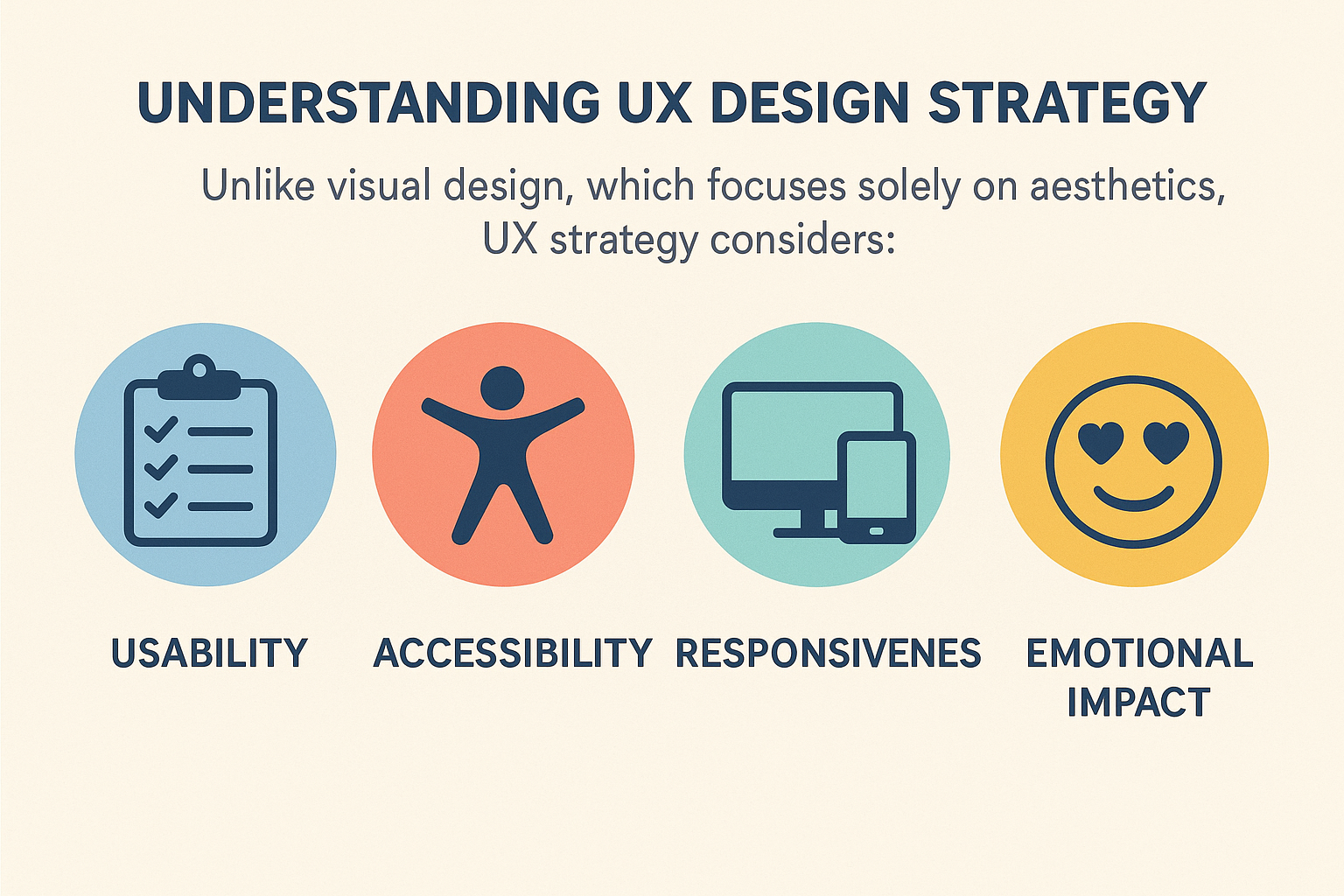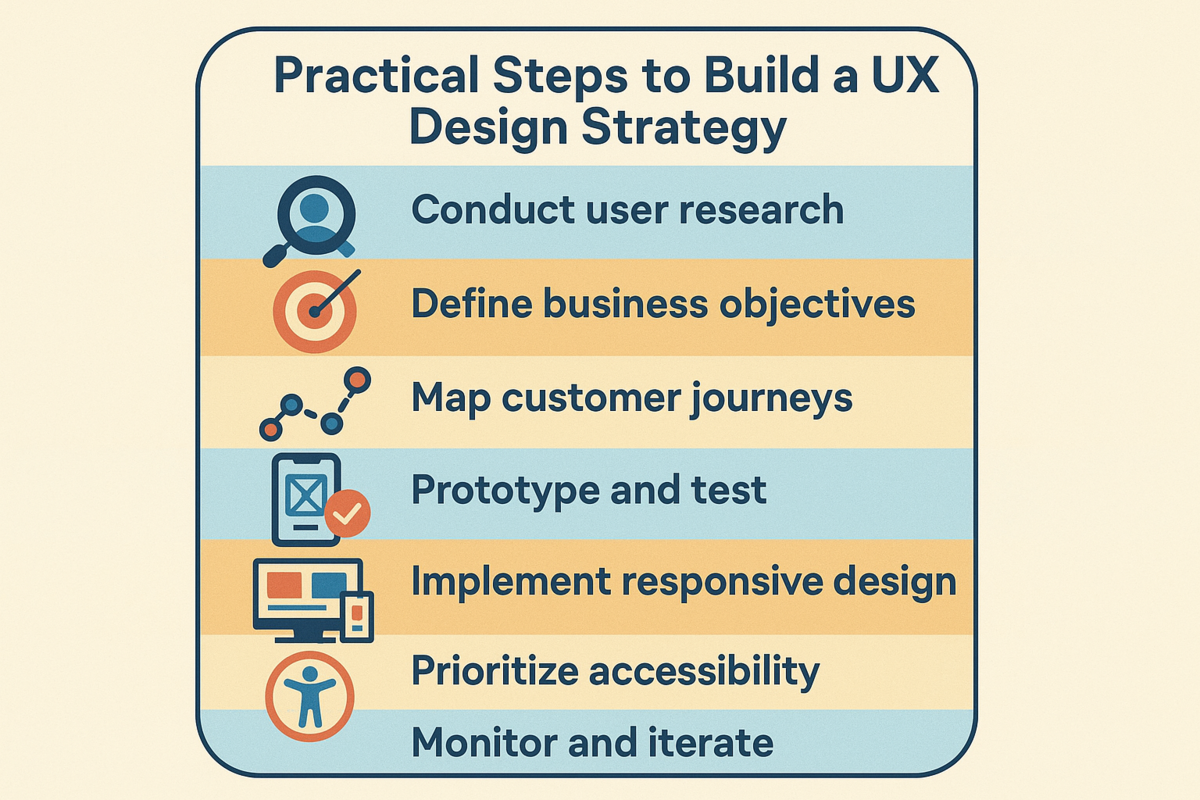The digital world has shifted the way customers interact with businesses. Websites, apps, and online platforms are no longer just tools, they are often the first impression a customer has of a brand.
If that first interaction is confusing, slow, or frustrating, users quickly move on. This reality highlights why a UX design strategy is critical.
User Experience (UX) design strategy is not simply about how a digital product looks; it’s about how it works, how it feels, and how well it serves the needs of the user.
Research from Forrester reveals that improving user experience can increase conversion rates by up to 400%, proving the direct impact of UX on measurable business success.
This article explores why UX design strategy is important, covering its role in customer satisfaction, business performance, inclusivity, loyalty, and cost savings.
It also outlines practical steps companies can take to implement UX effectively.
Understanding UX Design Strategy
A UX design strategy is a deliberate plan for creating user-centered digital experiences that align with business goals. It integrates research, design, and testing to ensure every touchpoint is intuitive and meaningful.

Unlike visual design, which focuses solely on aesthetics, UX strategy considers:
- Usability: Can users easily navigate and complete tasks?
- Accessibility: Can all users, including those with disabilities, interact effectively?
- Responsiveness: Does the product adapt across devices and platforms?
- Emotional Impact: Does the experience leave users satisfied and confident?
Industries such as Banking and Finance particularly benefit from strong UX strategies, as trust and clarity are vital when dealing with sensitive information like investments or transactions.
Businesses often begin their UX journey by enhancing their Creative Services, ensuring every element contributes to user-friendly experiences.
Enhancing Customer Satisfaction
The primary reason UX design strategy is important lies in its ability to improve customer satisfaction.
A seamless, enjoyable digital experience makes users feel valued, increasing their likelihood of staying longer and returning.
Customers are quick to abandon platforms that are difficult to navigate. On the other hand, platforms with clean layouts, intuitive search functions, and responsive designs foster engagement.
A satisfied customer is also more likely to recommend a brand, amplifying its reach through word-of-mouth.
In Real Estate, where users interact with complex data such as property listings, floor plans, and mortgage calculators, UX can make the difference between a completed inquiry and an abandoned session.
Clear filtering systems, virtual tours, and responsive design improve the entire experience.
Companies seeking to embed these elements effectively often turn to Web Design & Development Services, where usability and customer satisfaction are central to design choices.
Driving Measurable Business Outcomes
Beyond satisfaction, UX design directly impacts metrics like bounce rates, conversion rates, and revenue.
When a platform is optimized for ease of use, customers complete tasks with less effort, translating into tangible business growth.
Businesses often use content marketing tools to enhance their visibility and improve the user experience.
According to Adobe, companies that invest in UX are three times more likely to build customer loyalty and generate stronger conversion rates.
For example, how to increase conversion rate can be achieved with fast-loading pages, clear CTAs, and intuitive navigation, which reduce drop-offs and guide users smoothly through purchase journeys.
In industries like Luxury Brands, where perception is everything, UX ensures that exclusivity is complemented with simplicity.
For example, a luxury ecommerce store benefits from high-quality visuals paired with streamlined checkout processes, reflecting both brand prestige and customer convenience.
Ensuring Accessibility and Inclusivity
A robust UX design strategy ensures digital products are usable by everyone, regardless of ability or device. Inclusivity broadens the customer base and reflects positively on brand image.
Accessible design includes features like:
- Screen reader compatibility
- Scalable text sizes
- High-contrast visuals
- Voice navigation
- Mobile-first responsiveness
In the Technology sector, accessibility often defines whether a platform gains mass adoption. Users expect seamless experiences across desktop, mobile, and emerging devices like wearables.
By prioritizing inclusivity, businesses not only comply with accessibility standards but also demonstrate empathy and responsibility.
These goals can be embedded into long-term business plans through structured Digital Transformation Services, ensuring accessibility is treated as a strategic function rather than an afterthought.
Building Loyalty Through Design
UX is not just functional, it’s emotional. A user who enjoys an experience associates that positive feeling with the brand itself. Over time, this builds trust and loyalty.
Consider global brands like Apple or Airbnb. Their products are known not just for utility but for intuitive, elegant design. Customers return not just because of features, but because the experience is memorable and consistent.
In markets like Luxury Brands, this loyalty is especially important. Every touchpoint must reflect exclusivity, from browsing to checkout. A seamless journey becomes part of the brand promise.
Organizations achieve this balance by aligning aesthetics with usability through professional Design Services, ensuring consistency across every digital interaction.
Reducing Costs Through Strategic UX
Poor UX can be expensive. Fixing usability issues post-launch requires redesigns, redevelopment, and sometimes reputational repair.
By incorporating UX early in the process, through prototyping, testing, and user feedback, businesses save both time and money.
It is also critical to understand that optimizing your digital product for top search engines can help improve your visibility, making it easier for customers to find and engage with your brand.
According to IBM, the cost of fixing an error after development is up to 100 times higher than addressing it during design.
UX strategy mitigates these risks by catching issues early and prioritizing user needs before heavy investment in coding.
For industries with complex systems and long-term projects, streamlined collaboration via SharePoint Consulting Services ensures teams remain aligned, preventing miscommunication that leads to costly rework.
Gaining a Competitive Advantage
In saturated markets, UX often provides the edge needed to stand out. When pricing and products are similar, customers choose the brand that offers the best experience. A frictionless interface can become a major differentiator.
For example, in the Automotive sector, where car buyers research and compare models online, UX elements like interactive comparison tools, 3D car views, and responsive design enhance decision-making and give dealerships a competitive edge.
Companies gain this advantage by embedding UX principles into broader transformation initiatives with Digital Transformation Services, ensuring that customer experience is a strategic priority.
By applying best marketing tactics, businesses can leverage the full potential of a refined UX strategy to outpace competitors.
These steps are often supported by organizations enhancing their Creative Services, which bridge research insights with practical design execution.
Explore Our Web Design & Development Services!
7 Practical Steps to Build a UX Design Strategy
A well-defined UX design strategy is essential for creating seamless, user-centered experiences that drive engagement and satisfaction.
Here are seven practical steps to help you build a robust UX design strategy that aligns with your business goals and meets user needs.

- Conduct user research: Gather insights into customer pain points, motivations, and expectations.
- Define business objectives: Clarify how UX goals align with measurable outcomes.
- Map customer journeys: Visualize every touchpoint to identify and remove friction.
- Prototype and test: Build wireframes, test usability, and refine based on real feedback.
- Implement responsive design: Ensure experiences adapt seamlessly across devices.
- Prioritize accessibility: Design inclusively for users of all abilities.
- Monitor and iterate: Use analytics and customer feedback to continuously refine UX.
FAQs: Why UX Design Strategy is Important?
What is a UX design strategy?
A UX design strategy is a plan that connects user needs with business goals. It ensures digital products are intuitive, accessible, and effective through research, design, and testing.
Why is UX important in digital products?
UX determines how users interact with websites or applications. A strong UX reduces friction, builds satisfaction, and increases engagement, loyalty, and conversions.
How does UX impact business growth?
Good UX lowers bounce rates, improves conversions, and strengthens brand perception. Companies with strong UX strategies often see higher revenue and customer retention.
Is UX design only about visuals?
No. UX goes beyond visuals to include usability, navigation, accessibility, and the overall journey. Visuals are just one component of a broader strategy.
Which industries benefit most from a UX design strategy?
Every industry benefits, but sectors like finance, real estate, technology, and luxury retail rely heavily on UX to simplify complex interactions and build customer trust.
Conclusion
Why UX Design Strategy Is Important lies in its ability to effectively align user expectations with business objectives.
A strong UX design strategy ensures that digital products are not just visually engaging but also functional, inclusive, and able to achieve measurable business results.
From reducing bounce rates to building loyalty and securing competitive advantage, UX is a cornerstone of growth.
Companies that neglect UX risk losing users to competitors with smoother, more intuitive platforms.
Those that embed UX strategy into their processes, however, position themselves for sustainable success in a digital-first economy.
Centric underscores this principle by integrating customer-focused insights into Web Design & Development Services, helping organizations create seamless digital experiences that drive measurable growth and long-term loyalty.








